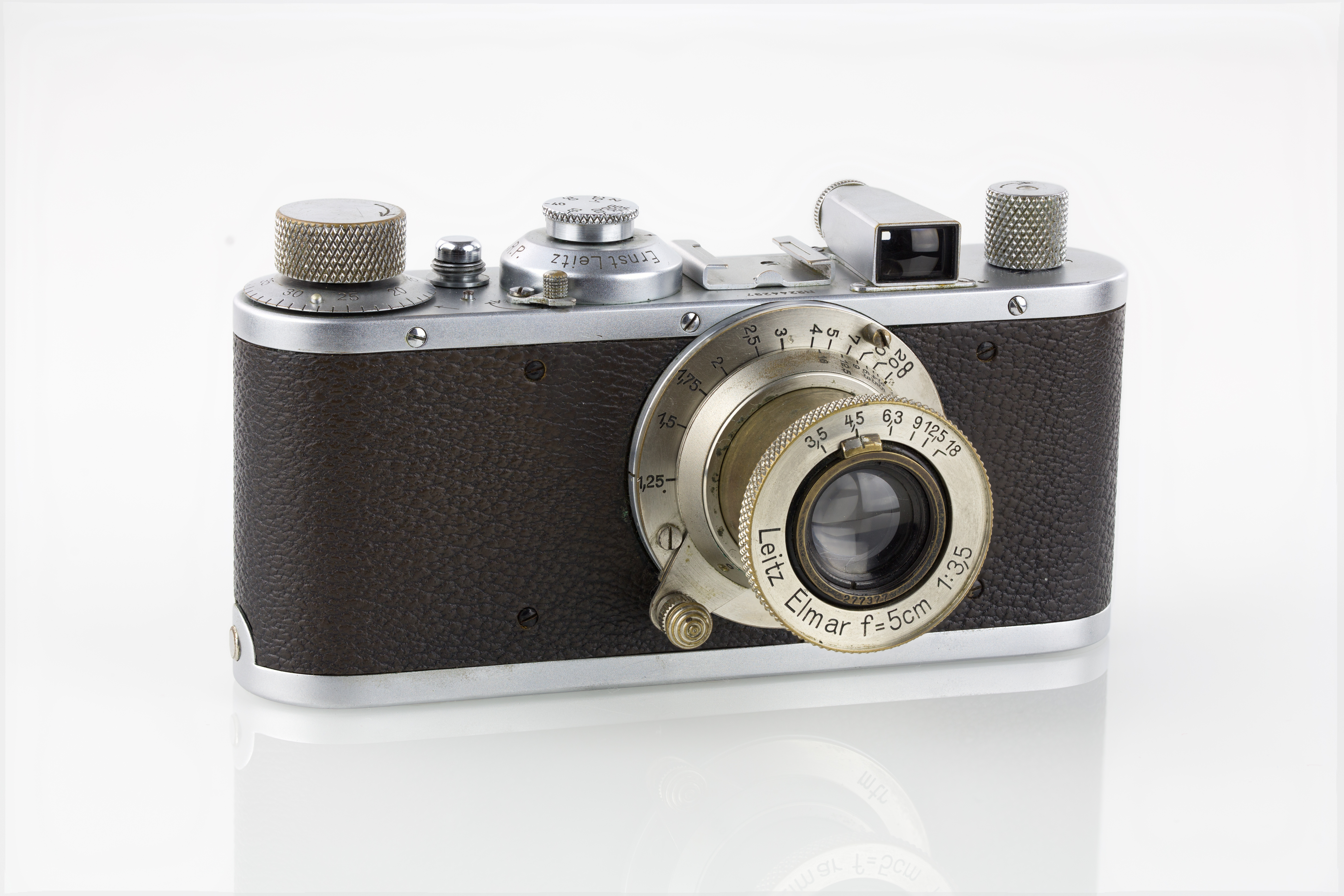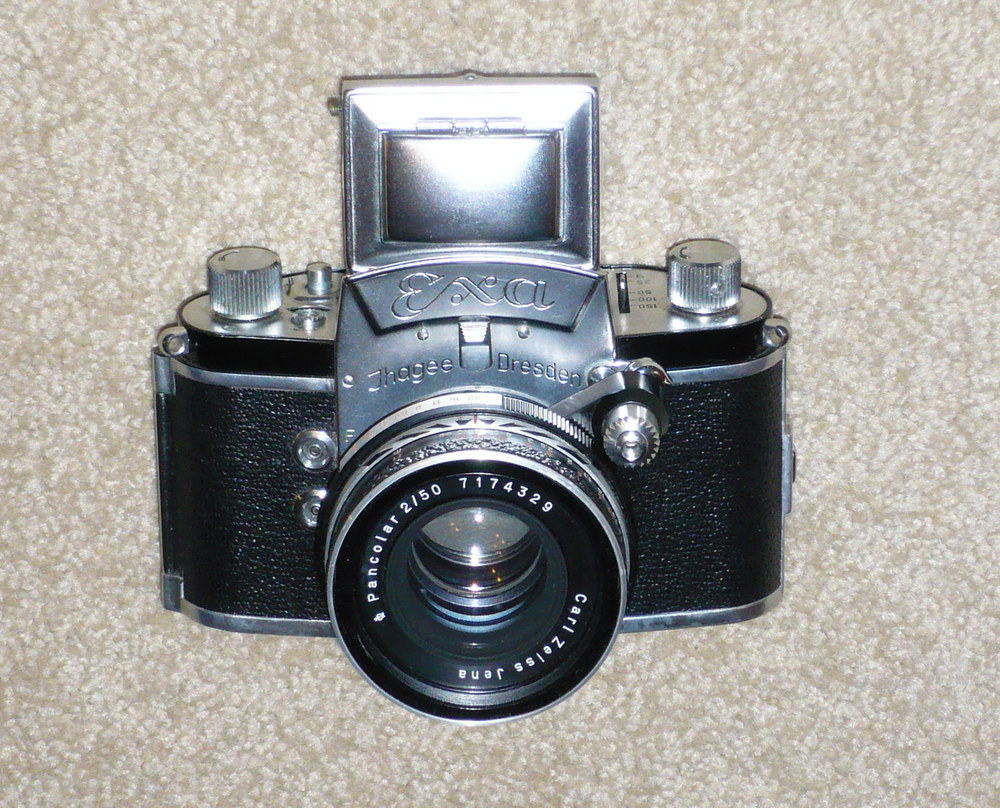|
Corfield Periflex
The Periflex 35mm camera was launched by K. G. Corfield Ltd, England in May 1953 as the first and original model from this source. The camera resembles the Leica Standard and qualifies fully as a Leica copy. However, film loading is by way of a removable back, and it provides through the lens visual focusing using an inverted periscope to be lowered into the light path between the lens and the film, utilising the single-lens reflex principle, showing a small section from the lower middle of the full image. The Periflex became quite popular in Britain and several improved models were introduced during the ensuing years until their demise in the early 1960s. Description The body is made of black painted metal alloy castings, while the top and base-plates are of black anodised stamped aluminium with delicate engravings. The covering material of the first two hundred units or so were brown pigskin, while all later ones were finished in black leather cloth because the pig skin stained ... [...More Info...] [...Related Items...] OR: [Wikipedia] [Google] [Baidu] |
Leica Standard
The Leica Standard, Model E was the fourth version of the original ''35 mm'' Leica camera to be launched from Ernst Leitz in Wetzlar, Germany. The concept was conceived by their employee Oskar Barnack in 1913. Production of the camera began in 1925 but it was not until the end of the decade that it was perfected and full-scale production was established. History The Leica Standard, Model E was the fourth version of the original ''35 mm'' Leica camera to be launched from Ernst Leitz in Wetzlar, Germany. The concept was conceived by their employee Oskar Barnack in 1913 at which time two prototypes were built. However, it was not until 1924 that Leitz decided to go ahead with the concept and production began the following year. By the end of the decade, the camera had been perfected and full-scale production was established. The Leica Standard was introduced as a basic model by Ernst Leitz, Wetzlar in October 1932. The camera began production in the same year as the Leica II with ... [...More Info...] [...Related Items...] OR: [Wikipedia] [Google] [Baidu] |
Leica Copies
The Leica copies originate from the Leica camera that was launched by Ernst Leitz, Wetzlar in 1925, using the Leica 39mm screw mount of 26 threads per inch (25.4 mm), and the standard 35mm film. The design was carried out by Oskar Barnack, beginning in 1913 by building a camera for ''24×36 mm'' negatives that by now is called the ''Ur-Leica''; but Ernst Leitz did not decide to manufacture it until 1924. Once started, the Leica production volume doubled each year; in 1929, some 16.000 cameras were produced. In 1930, an improved model with interchangeable lens was introduced, followed a year later by the fully developed ''Leica II'' with standardized film to lens flange distance, and in 1932 the basic ''Leica Standard''; the Leica concept was established. This camera's features are the basis for defining a Leica copy. The post 1932 Leica II and Leica III cameras were differentiated by the latter having a "slow speed dial" on the front of the camera to the left of the lens mount ... [...More Info...] [...Related Items...] OR: [Wikipedia] [Google] [Baidu] |
Single-lens Reflex
A single-lens reflex camera (SLR) is a camera that typically uses a mirror and prism system (hence "reflex" from the mirror's reflection) that permits the photographer to view through the lens and see exactly what will be captured. With twin lens reflex and rangefinder cameras, the viewed image could be significantly different from the final image. When the shutter button is pressed on most SLRs, the mirror flips out of the light path, allowing light to pass through to the light receptor and the image to be captured. History File:Hasselblad 1600F.jpg, Medium format SLR by Hasselblad (Model 1600F), Sweden File:Zenza BRONICA S2 with ZENZANON 100mm F2.8.JPG, Medium format SLR by Bronica (Model S2), Japan. Bronica's later model—the Bronica EC—was the first medium format SLR camera to use an electrically operated focal-plane shutter File:Asahiflex600.jpg, The 1952 (Pentax) Asahiflex, Japan's first single-lens reflex camera. File:Contaflex BW 2.JPG, The Contaflex III a s ... [...More Info...] [...Related Items...] OR: [Wikipedia] [Google] [Baidu] |
Viewfinder
In photography, a viewfinder is what the photographer looks through to compose, and, in many cases, to focus the picture. Most viewfinders are separate, and suffer parallax, while the single-lens reflex camera lets the viewfinder use the main optical system. Viewfinders are used in many cameras of different types: still and movie, film, analog and digital. A zoom camera usually zooms its finder in sync with its lens, one exception being rangefinder cameras. History Before the development of microelectronics and electronic display devices, only optical viewfinders existed. Direct optical viewfinders Direct viewfinders are essentially miniature Galilean telescopes; the viewer's eye was placed at the back, and the scene viewed through the viewfinder optics. A declining minority of point and shoot cameras use them. Parallax error results from the viewfinder being offset from the lens axis, to point above and usually to one side of the lens. The error varies with distance, bei ... [...More Info...] [...Related Items...] OR: [Wikipedia] [Google] [Baidu] |
Focal-plane Shutter
In camera design, a focal-plane shutter (FPS) is a type of photographic shutter that is positioned immediately in front of the focal plane of the camera, that is, right in front of the photographic film or image sensor. Two-curtain shutters The traditional type of focal-plane shutter in 35 mm cameras, pioneered by Leitz for use in its Leica cameras, uses two shutter curtains, made of opaque rubberised fabric, that run horizontally across the film plane. For slower shutter speeds, the first curtain opens (usually) from right to left, and after the required time with the shutter open, the second curtain closes the aperture in the same direction. When the shutter is cocked again the shutter curtains are moved back to their starting positions, ready to be released. Focal-plane shutter at low speed ''Figure 1:'' The black rectangle represents the frame aperture through which the exposure is made. It is currently covered by the first shutter curtain, shown in red. The se ... [...More Info...] [...Related Items...] OR: [Wikipedia] [Google] [Baidu] |
Synchronising
Synchronization is the coordination of events to operate a system in unison. For example, the conductor of an orchestra keeps the orchestra synchronized or ''in time''. Systems that operate with all parts in synchrony are said to be synchronous or ''in sync''—and those that are not are ''asynchronous''. Today, time synchronization can occur between systems around the world through satellite navigation signals and other time and frequency transfer techniques. Navigation and railways Time-keeping and synchronization of clocks is a critical problem in long-distance ocean navigation. Before radio navigation and satellite-based navigation, navigators required accurate time in conjunction with astronomical observations to determine how far east or west their vessel traveled. The invention of an accurate marine chronometer revolutionized marine navigation. By the end of the 19th century, important ports provided time signals in the form of a signal gun, flag, or dropping time ... [...More Info...] [...Related Items...] OR: [Wikipedia] [Google] [Baidu] |




